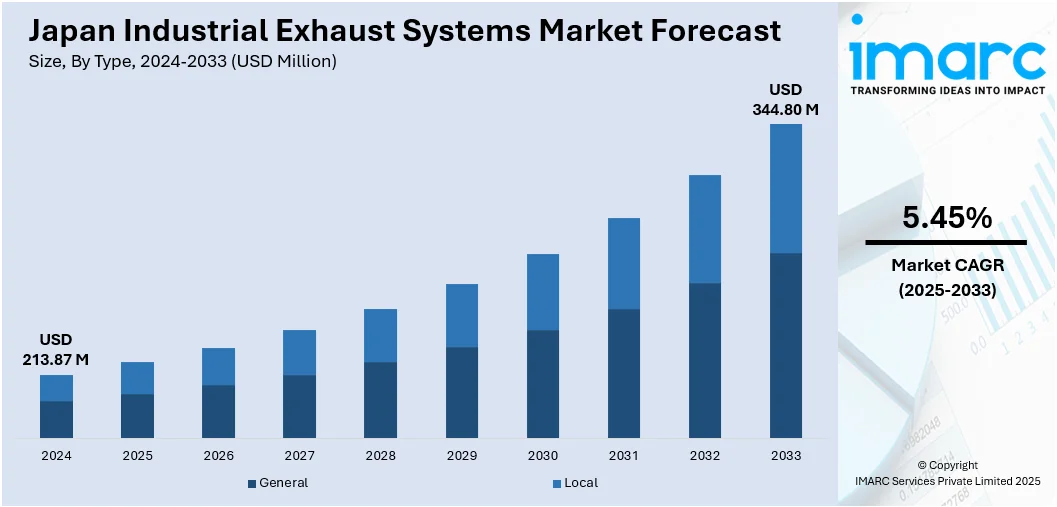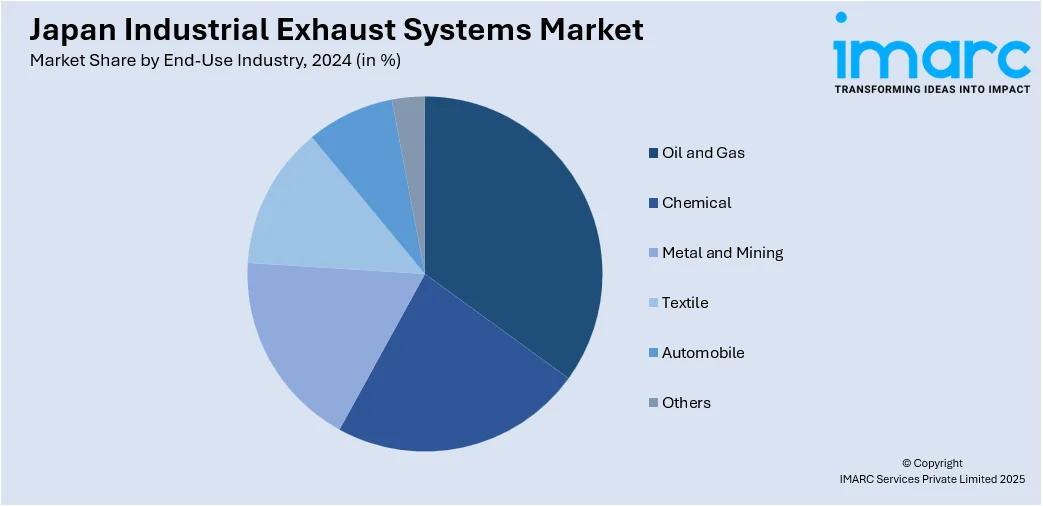
Japan Industrial Exhaust Systems Market Size, Share, Trends and Forecast by Type, End-Use Industry, and Region, 2025-2033
Japan Industrial Exhaust Systems Market Overview:
The Japan industrial exhaust systems market size reached USD 213.87 Million in 2024. Looking forward, IMARC Group expects the market to reach USD 344.80 Million by 2033, exhibiting a growth rate (CAGR) of 5.45% during 2025-2033. The market is driven by stringent environmental regulations and rising energy costs, compelling industries to adopt energy-efficient exhaust systems with VFDs and heat recovery technologies. Increasing adoption of smart, AI-driven exhaust systems, enabled by Industry 4.0 advancements, enhances operational efficiency and compliance in sectors. Government initiatives toward carbon neutrality and workplace safety further are further augmenting the Japan industrial exhaust systems market share.
|
Report Attribute
|
Key Statistics
|
|---|---|
|
Base Year
|
2024
|
|
Forecast Years
|
2025-2033
|
|
Historical Years
|
2019-2024
|
| Market Size in 2024 | USD 213.87 Million |
| Market Forecast in 2033 | USD 344.80 Million |
| Market Growth Rate 2025-2033 | 5.45% |
Japan Industrial Exhaust Systems Market Trends:
Increasing Demand for Energy-Efficient Industrial Exhaust Systems
The market is witnessing a growing demand for energy-efficient solutions due to rising energy costs and stringent environmental regulations. In 2023, Japan witnessed its total energy consumption fall by 3.5%, at 391 Mtoe, with per capita electricity consumption at 7.3 MWh and energy self-reliance standing at only 16.5%, while it points towards continued dependence on imports and high energy costs. The industrial sector remains the largest electricity user, at 36%, as renewable sources powered the energy supply by 27.5%. These advances highlight the imperative need for energy-efficient industrial exhaust systems to help Japanese manufacturers reduce operating expenses and carbon emissions. Manufacturers are increasingly adopting sophisticated technologies, including variable frequency drives (VFDs), heat recovery systems, and energy-efficient fans, to reduce operational costs and carbon footprints. The government’s push toward carbon neutrality by 2050 is further accelerating this trend, with industries investing in sustainable exhaust systems to comply with emissions standards. Additionally, industries such as automotive, chemical, and electronics are prioritizing energy-efficient ventilation to enhance workplace safety and productivity. Companies are also integrating IoT-enabled monitoring systems to optimize airflow and energy usage in real time. As a result, suppliers focusing on high-efficiency, eco-friendly exhaust systems are gaining a competitive edge in the Japanese market.

To get more information on this market, Request Sample
Adoption of Smart and Automated Exhaust Systems
The shift toward smart and automated solutions driven by Industry 4.0 advancements is further propelling the Japan industrial exhaust systems market growth. Japan's Society 5.0 vision, moving beyond Industry 4.0, embraces the Internet of Things, artificial intelligence, and robotics to transform key industries including transportation, healthcare, and infrastructure, supported by a ¥4.2 trillion (USD 38 Billion) science, technology, and innovation budget in 2019. With smart infrastructure and automation at the center of this digital revolution, industrial exhaust systems manufacturers are likely to see increased demand for intelligent, cyber-physical systems. This program also supports Japan's sustainability efforts and alignment with the Sustainable Development Goals, which will be strongly showcased at EXPO 2025 in Osaka. Factories are increasingly implementing AI-based exhaust systems equipped with sensors and automated controls to oversee air quality, modify ventilation rates, and anticipate maintenance requirements. These systems improve operational efficiency by reducing manual intervention and minimizing downtime. The growing emphasis on workplace safety and air quality compliance is also fueling demand for intelligent exhaust systems, particularly in sectors, such as pharmaceuticals, food processing, and semiconductor manufacturing. Furthermore, cloud-based analytics platforms are being used to track emissions data and ensure regulatory adherence. As Japanese industries continue to modernize their facilities, the integration of smart exhaust technologies is expected to become a standard practice, driving market growth.
Japan Industrial Exhaust Systems Market Segmentation:
IMARC Group provides an analysis of the key trends in each segment of the market, along with forecasts at the country and regional levels for 2025-2033. Our report has categorized the market based on type and end-use industry.
Type Insights:
- General
- Local
The report has provided a detailed breakup and analysis of the market based on the type. This includes general and local.
End-Use Industry Insights:

- Oil and Gas
- Chemical
- Metal and Mining
- Textile
- Automobile
- Others
A detailed breakup and analysis of the market based on the end-use industry have also been provided in the report. This includes oil and gas, chemical, metal and mining, textile, automobile, and others.
Regional Insights:
- Kanto Region
- Kansai/Kinki Region
- Central/ Chubu Region
- Kyushu-Okinawa Region
- Tohoku Region
- Chugoku Region
- Hokkaido Region
- Shikoku Region
The report has also provided a comprehensive analysis of all the major regional markets, which include Kanto Region, Kansai/Kinki Region, Central/ Chubu Region, Kyushu-Okinawa Region, Tohoku Region, Chugoku Region, Hokkaido Region, and Shikoku Region.
Competitive Landscape:
The market research report has also provided a comprehensive analysis of the competitive landscape. Competitive analysis such as market structure, key player positioning, top winning strategies, competitive dashboard, and company evaluation quadrant has been covered in the report. Also, detailed profiles of all major companies have been provided.
Japan Industrial Exhaust Systems Market Report Coverage:
| Report Features | Details |
|---|---|
| Base Year of the Analysis | 2024 |
| Historical Period | 2019-2024 |
| Forecast Period | 2025-2033 |
| Units | Million USD |
| Scope of the Report |
Exploration of Historical Trends and Market Outlook, Industry Catalysts and Challenges, Segment-Wise Historical and Future Market Assessment:
|
| Types Covered | General, Local |
| End-Use Industries Covered | Oil and Gas, Chemical, Metal and Mining, Textile, Automobile, Others |
| Regions Covered | Kanto Region, Kansai/Kinki Region, Central/ Chubu Region, Kyushu-Okinawa Region, Tohoku Region, Chugoku Region, Hokkaido Region, Shikoku Region |
| Customization Scope | 10% Free Customization |
| Post-Sale Analyst Support | 10-12 Weeks |
| Delivery Format | PDF and Excel through Email (We can also provide the editable version of the report in PPT/Word format on special request) |
Key Questions Answered in This Report:
- How has the Japan industrial exhaust systems market performed so far and how will it perform in the coming years?
- What is the breakup of the Japan industrial exhaust systems market on the basis of type?
- What is the breakup of the Japan industrial exhaust systems market on the basis of end-use industry?
- What is the breakup of the Japan industrial exhaust systems market on the basis of region?
- What are the various stages in the value chain of the Japan industrial exhaust systems market?
- What are the key driving factors and challenges in the Japan industrial exhaust systems market?
- What is the structure of the Japan industrial exhaust systems market and who are the key players?
- What is the degree of competition in the Japan industrial exhaust systems market?
Key Benefits for Stakeholders:
- IMARC’s industry report offers a comprehensive quantitative analysis of various market segments, historical and current market trends, market forecasts, and dynamics of the Japan industrial exhaust systems market from 2019-2033.
- The research report provides the latest information on the market drivers, challenges, and opportunities in the Japan industrial exhaust systems market.
- Porter's five forces analysis assist stakeholders in assessing the impact of new entrants, competitive rivalry, supplier power, buyer power, and the threat of substitution. It helps stakeholders to analyze the level of competition within the Japan industrial exhaust systems industry and its attractiveness.
- Competitive landscape allows stakeholders to understand their competitive environment and provides an insight into the current positions of key players in the market.
Need more help?
- Speak to our experienced analysts for insights on the current market scenarios.
- Include additional segments and countries to customize the report as per your requirement.
- Gain an unparalleled competitive advantage in your domain by understanding how to utilize the report and positively impacting your operations and revenue.
- For further assistance, please connect with our analysts.
 Request Customization
Request Customization
 Speak to an Analyst
Speak to an Analyst
 Request Brochure
Request Brochure
 Inquire Before Buying
Inquire Before Buying




.webp)




.webp)












